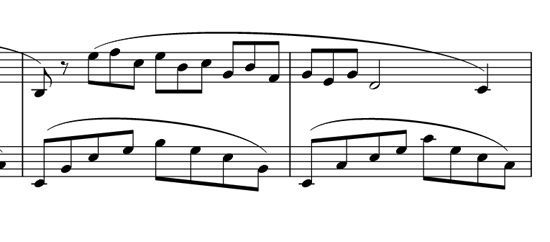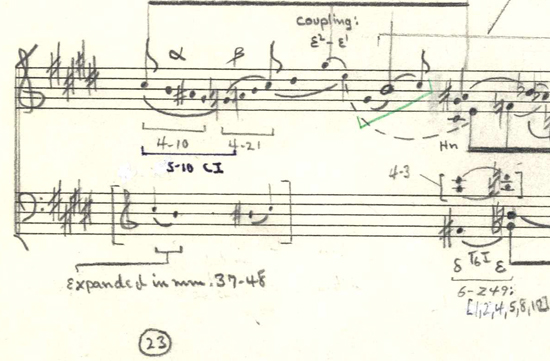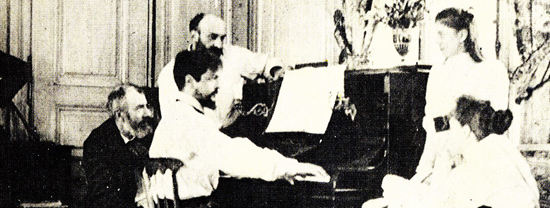It was the Albany hip hop producer Daimyo who first introduced me to this mesmerizing gem. In discussing Oltremare, I wandered into timbre, formants, and most of all, music visualization. The system that you see above was developed by Stephen Malinowski, and the color-coding and linear connects make it the most instructive and useful way to visualize a musical score I've found so far. Debussy is not a mess of notes, there is a geometric motion and internal logic to the Arabesque that this animation captures nicely.
The opening revolves around E major but colors all over those lines, bringing out some wild overtones with pentatonic riffs. It makes sense I would be drawn to this: it's the common ground between Slayer and Djelimady Tounkara. The hook, without question, is those gorgeous descending lines that come in at the 0:23 mark, a dancing counterpoint that triggers some serious synaesthesia. That's the result of syncopation at work, a brain-tickling perceptual illusion triggered by playing the descending triplets over the sweeping 8th notes of that bass arpeggio:

Debussy: "The musical arabesque, or rather the principle of ornament, is at the basis of all forms of art. The divine arabesque was used by Palestrina and Orlando. They discovered its principle in Gregorian Chant and provided support for its interlaced designs with strong counterpoint."
Throughout his career, Debussy was always quick to give credit to his predecessors and inspirations, and this rich lineage has given music critics a great deal to write about. (Here's one very intense example.) As you can imagine, though, there is little to be said about Debussy that's as interesting as the music itself.
It was the horizons that Debussy was most interested in, the inherent possibilities of music. He was fascinated by iteration and permutation, and wrote with a very long-term legacy in mind. For illustration purposes, here's a valuable comparison: "Reverie" performed by two masterful players, one behind a piano and the other gently fingering a guitar...
Both of these "Reverie" performances are compromises & interpretations. Deric Bownds brings what he wants out of the composition, and if you peruse the comments, you'll see a lot of folks chiding him for rushing the tempo and taking liberties -- but this unfaithful adaptation is precisely what makes his version work. Which brings me to the real point of this: what makes Debussy work so well in the first place?
There's a lot of myths about the Golden Ratio being encoded throughout the scores of Debussy, but evidence is mixed at best. In fact, it's the gently broken nature of his work, his willingness to push out into dissonant spaces, that keeps me so compelled by his music, so he obviously deviates from the pure harmonies of Pythagoras. Both his contemporaries and his subsequent biographers have noted that Debussy was unusually preoccupied with something that also happens to obsess me: timbre, the distinct tonality of instruments, rooms and equipment.

Consider Prelude to the Afternoon of a Faun, something I strongly advise taking in at high volume and on sparkly drugs. Incorporating bassoons, clarinets, flutes, oboes, harps...note the plural usage. Throughout the piece, you hear Debussy pushing the instruments to make sounds only they can make and hold notes that resonate with the physical instrument. He also takes advantage of the fact there's at least two of everything, unleashing all manner of minor key intervals that straddle the harmony/dissonance gap and, again, emphasize resonance.
Debussy's interest was artistic and philosophical, but in 2012 the principles of resonance and dissonance are fully weaponized concepts, manifested as the LRAD crowd control unit. None of this is obscure or academic.
It can be beautiful, though. Here's contemporary songwriter David Rawlings, talking about his own love of dissonance and the unique timbre of a perfectly shitty guitar...
So: back to our beautiful Arabesque. In the Malinowski animation this all began with, it's being performed on solo piano, a devilishly impressive feat considering most piano transcriptions are written for "Four Hands." Still, as the video makes clear, the layout of the song is a counterpoint conversation between the bass and treble. The raw complexity is similar to the classic crab canon, Bach's The Musical Offering, but far looser -- Debussy was writing soundtracks prior to the invention of cinema. Here's a charmingly goofy example of how the duet format opens the piece up: a classical guitar and an accordion.
As the man himself noted, "works of art make rules, but rules do not make works of art." He had a rare ear for beautiful riffs from far outside traditional music theory, and he also had a mathematician's patience, tinkering with orchestrations until he found arrangements that clicked, building without blueprints.
I have been tinkering with the first Arabesque on guitar for months now and I'm starting to view it as a mathematical object like the Mandelbrot set. There's a tremendous amount of ideas packed into an apparently breezy little exercise, and a playful self-similarity I recognize from natural fractals. There is ultimately such an abundance of math inside the Arabesque it becomes a sort of Rorschach test. Some folks see parallel chord movement and other see bitonal architecture and nobody is exactly wrong.
Meanwhile, I keep trying to find all the sweet spots.
"An examination of the harmonic techniques out of their context has all too often led to misleading terminology such as 'static' or 'non-functional' as a description of Debussy's harmonic methods. Viewed as a whole, however, the tonal coherence of his music depends upon a carefully calculated and often dramatic interaction of these various harmonic 'types' with each other and with orthodox diatonic harmony. The result is a tonal language, but one which is fundamentally different in concept from classical tonality. The detailed classifications of harmonic events is no longer possible in Debussy's music where the central tonality of a work emerges only through a constant focusing and re-focusing on harmonic types." - Jim Samson

"Search for a discipline within freedom! Don't let yourelf be governed by formulae drawn from decadent philosophies: they are for the feeble-minded. Listen to no one's advice except that of the wind in the trees. That can recount the whole history of mankind..." - Claude Debussy, 1862-1918

simply wonderful...thanks so much for including me!
ReplyDelete